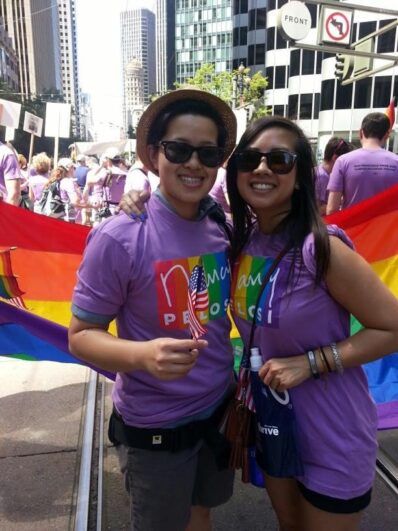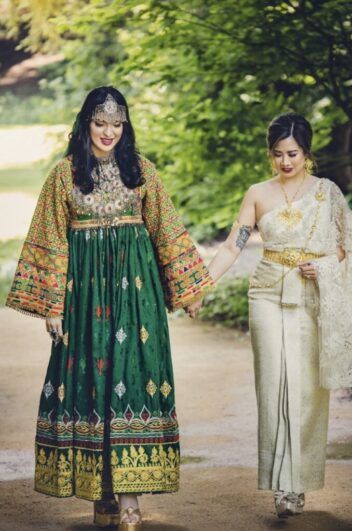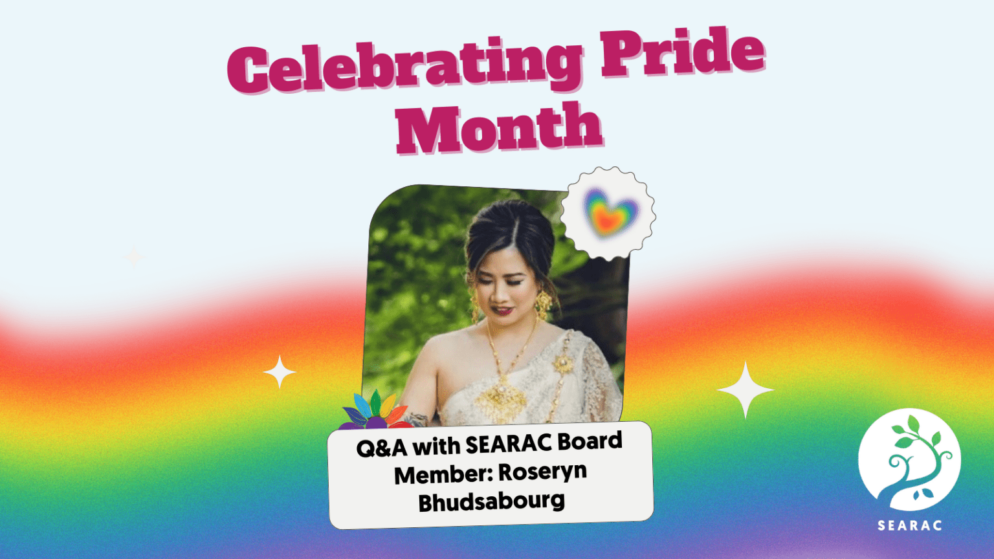Sou Saechao, SEARAC 2023 summer Communications Intern, connected with a few members of SEARAC’s board to discuss their reflections on Pride Month and its intersectionality with Southeast Asian American activism.
For his second interview in this two-part series, Sou sat down with SEARAC board member Roseryn Bhudsabourg, a government relations professional with a decade of experience in public policy, community outreach, and advocacy. Roseryn is currently the Supervising Program Administrator for the Office of Government Relations with the Santa Clara Valley Water District, the largest multi-purpose water supply, watershed stewardship, and flood management special district in California. Roseryn previously served as a Senior Assistant and Communications Director at the California State Assembly in Sacramento, where she managed legislation and provided communications support to more than 100 bills, advised on key policy decisions, and conducted research and analyses of a broad range of policy issues, including environmental sustainability and social justice. She was also a member of the 2020 Staff Academy cohort of the California Asian Pacific Islander Legislative Caucus Institute and the Capitol LGBTQ Association.
Check out their full Q&A below:
Sou: What does Pride Month mean to you?
Roseryn: Pride to me is a celebration of the very diverse LGBTQIA+ community and a continuing celebration of history that’s rooted in activism and intersectionality. There’s no one way to celebrate Pride because it can be personal—a celebration of self-worth and dignity—or it can be big and loud; a rallying cry to uplift marginalized voices and ensuring that everyone has a seat at the table. I think Pride Month is meant to evolve to meet the needs of the community.

Sou: Has Pride Month changed for you throughout the years?
Roseryn: Pride Month has absolutely changed for me. When I first started participating in Pride Month in my younger years, it was more about finding out who I was and my individual identity. I recognized then that I was gay, but I didn’t quite know where I fit in in the larger community. I grew up in the 90’s not seeing a lot of LGBTQIA+ people in mainstream media who I felt represented me, even when Pride Month was being celebrated in different cities across the country. I didn’t see people on television or in films who looked like me or shared my experiences. Through the years, I found others who also didn’t “belong” and then Pride Month became a space for us to celebrate our own stories as Southeast Asian queers. We built our own communities that are now more inclusive and representative of the diversity that always existed but wasn’t always quite at the forefront. That’s my kind of Pride Month now.
Sou: What does it mean to be both queer and Southeast Asian?
Roseryn: This is something that I struggled a lot with growing up, thinking those were two things that couldn’t possibly coexist. A lot of us in the Southeast Asian community grew up in households that were socially and culturally conservative. It’s already enough of a challenge being a minority, let alone a gay one. For a long time, I kept those two parts of me separate from one another. It felt like a necessary sacrifice to ensure that I could be both an agreeable, non-controversial daughter to my parents on one hand, and a good social justice activist fighting for the good cause on the other. Over time, my perspective changed, and I stopped viewing either identity as a barrier to the other. Thanks to shifting worldviews and growing acceptance of LGBTQIA+ communities, there has been so much progress that has been made in terms of civil rights and it’s hard not to recognize the intersection between AAPI communities and LGBTQIA+ communities. Both are communities that have been marginalized for being different, and we’ve spent far too long thinking that our struggles are somehow separate. So, what does it mean to me to be queer and Southeast Asian? It means that I can—and should—be proud of being both.

Sou: How has being a part of the LGBTQ+ community shaped/influenced your work?
Roseryn: My entire career has been in public service, and I can tell you that at a staff level through the leadership and elected official level, this is not a space that’s regarded for its diversity. However, for a government to function well, it needs to be representative of the communities it serves otherwise it risks losing out on diverse skills, knowledge, and experiences. I was drawn towards work that would provide me with the resources and platforms to advocate for diversity and highlight it as an asset rather than a problem. Being part of the LGBTQIA+ community gives you unique insight in all the ways we are still striving for fairness and equality in our lives and this is a perspective that continues to inform my day-to-day decisions, whether internally or through public policy. I feel a personal responsibility to be inclusive and equitable in all the work I take on, and not only uplift the communities I identify with, but also others that remain majorly underrepresented.
Sou: What do you want to tell other LGBTQ Southeast Asian American community members?
Roseryn: I would remind those still seeking their community that they are not alone, and that there are opportunities everywhere to be connected with each other. And if those spaces don’t yet exist due to barriers beyond your control, give yourself grace and know that chances are, there also are others hoping for the same. May you find each other. And for those who have already established their own LGBTQIA+ Southeast Asian American stronghold, remember that there’s still a lot of work to be done to maintain the progress that’s been made. Keep fighting the good fight and be proud while doing it.
For more blogs in our Pride Month blog series, see: “Celebrating Pride Month: Part 1”

